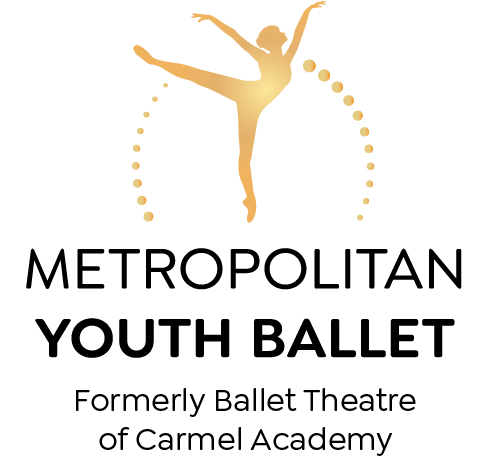We changed our name! Ballet Theatre of Carmel Academy is now Metropolitan Youth Ballet. This is a change in name only — our tremendous faculty and outstanding instruction remains the same.
We will have a new studio home later this year! This state-of-the-art facility is located at 6210 Technology Center Drive, Suite 200, Indianapolis, just 10 minutes from our current location. Look for more information and a timeline coming soon. We understand that a different location may change logistics for some, so we encourage you to familiarize yourselves with our withdrawal policy in case an adjustment to your dancer’s registration becomes necessary.
Classes
Metropolitan Youth Ballet (MYB) offers movement and ballet classes for the youngest dancers in the Preschool Division, and more structured ballet technique classes for dancers from Primary A through Level 6B. Classes follow the ABT® National Training Curriculum which outlines a set of milestones at each level for the dancer to master in order to advance to a higher level. In addition to ballet technique classes, MYB offers a variety of classes focusing on other aspects of classical ballet. Unsure of the best classes for your dancer? Call us at 317-798-2133.
Pre-Pointe is a pointe preparation class for serious ballet students interested in dancing en pointe. Pre-Pointe is a 30-minute class that meets weekly or bi-weekly, usually after the student’s ballet class. The class is initially taken barefoot to develop dexterity and strength in the toes and metatarsals along with a general conditioning of the body. At the instructor’s discretion, the dancer will graduate to wearing “pre-pointe” shoes – a modified version of a pointe shoe which provides the texture and feel of the harder sole and box of a pointe shoe but does not allow a dancer to go up onto the tip of the shoes.
A dancer is invited into pre-pointe class once she displays correct posture and placement in ballet class, and demonstrates adequate muscle control.
After mastering pre-pointe shoes and developing the necessary strength and control, a dancer will, at the discretion of their instructor, transition to Pointe class. Pointe class is 30 minutes, usually after the student’s ballet class. Early pointe classes are done solely with the support of the barre and center work is introduced very gradually. Dancers should expect the pre-pointe/pointe education phase to span a minimum of at 2 years before a dancer is deemed proficient enough to dance off the barre independently. This will ensure the proper and well-phased development in a dancer’s pointe technique. If a dancer moves through their pointe training period too rapidly it can lead to bad habits and ultimately severe injuries.
A Variation is a short dance (solo, duet, or trio) from a full-length ballet. Variations class is offered to Upper/Pre-Professional Division pointe students with a strong technical foundation. Variations class teaches dancers stamina, spacing, stage presence, and students will be exposed to a wide variety of technical styles, stories and steps while learning some of the most famous choreography in the ballet world!
Pas de Deux class is offered, by invitation of the Artistic Staff, to level 4A-6B dancers. The class focuses on understanding how male and female dancers work together. Our instructors work with dancers on technique, support, balance, coordination, lifting, and trust, and will tailor the class work to the level/ability of the dancers. Beginning work might include basic weight transfer exercises, promenades in various positions, pirouettes from fourth and finger turns. Lifts begin small and broken into segments, and work up to more complicated full lifts. Pas de Deux is a vital part of our curriculum to prepare dancers for our performances and potential performing careers, as well as just the enjoyment of learning to partner!
Character dance is a stylized representation of traditional folk or national dance. In classical ballets, Character dances are usually used to depict large scenes of gatherings, royal parties or festivals, and are often a joyous and celebratory part of a ballet. Character class uses music and dances from all over the world which have been adapted for theater, and helps students develop musicality, stage presence, and expressiveness.
The Teen/Adult Ballet class has been designed specially for those with no previous experience but an interest in learning the basics of classical ballet, as well as for former dancers who have been away from the field for a while but want to keep their dancers’ muscle memory. Suitable for all skill levels, this class focuses on strengthening and toning the whole body while having fun!
Contemporary ballet utilizes elements and techniques from other styles of ballet—classical, romantic, and neoclassical—and combines them with improvisation and freer movements to create a style that’s expressive and nontraditional.This class will teach students technical skills, musicality, and expression of emotions through dance.
Jazz combines many styles and techniques from ethnic and contemporary dance to ballet. Our Jazz class teaches basic and more advanced (depending on the level) jazz dance steps, terminology and style with an emphasis on proper technique, alignment and movement quality. Class work and choreography is set to age appropriate jazz, R&B, ethnic and pop music.
Improvisation in dance is the process of spontaneously creating movement. Dancers in the Improvisation class are cued and encouraged to free the body from habitual movement patterns or mental blocks through topics, exercises and creative explorations of dramatic themes, abstract concepts, ideas of shapes and dynamics, partnering/group work, and a variety of planes of movement. Improv helps dancers (ballet dancers in particular), to break through fears of being different, wrong, or not good enough and to learn to move freely and compose dance in the moment to cultivate their unique voices as artists.
School Divisions and Class Levels
Metropolitan Youth Ballet offers class levels ranging from Preschool through Pre-Professional Level 6B. Click below to read more about each of our Divisions and the levels associated with each.
